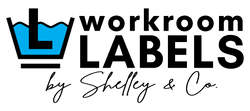Label terminology
Handle
The feel of a fabric/material.
Hot-cut
When heat is used to cut the labels and this melts the polyester fibres creating a sealed and non-fraying edge
Fibre content
The fibres content is a list of the "ingredients" of the material. It tells us where that material comes from/the make up of the fabric. There is a list of generic names that can be used in the list of fibre content.
Fraying
When the weave ends of a material/fabric come undone and the yarns become loose
Overlocking
A type of sewing machine stitch which encases all the raw edges of material and stops fraying
Pip
A small label which is usually in the loopfold/centrefold style and only sticks out around 1cm/10mm
Seam allowance
The area of the label which is left blank usually for inserting into the seam allowance of a textile item or into an overlocked edge
Fold/label types
For a full list of label types with images see our label types pageEndfold
A type of label which usually runs horizontally and the left and right ends are folded underneath. The label gets sewn down each folded side.
Loopfold
A type of label the same as a centrefold but without a pre-folded crease in the centre.
Centrefold
A type of label which folds in the centre and the two loose ends are usually sewn into a seam.
Weave types

Plain weave
A type of fabric weave which has the warp and weft threads going one over, one under to create a plain checkerboard type weave. The smoothness of the material depends on the denier (thickness) of the thread.
Twill
A type of fabric weave which has diagonal lines/ridges.
Sateen & Satin
A type of fabric weave which has long lengths of the thread at the surface/face side which creates a smoother feel.
